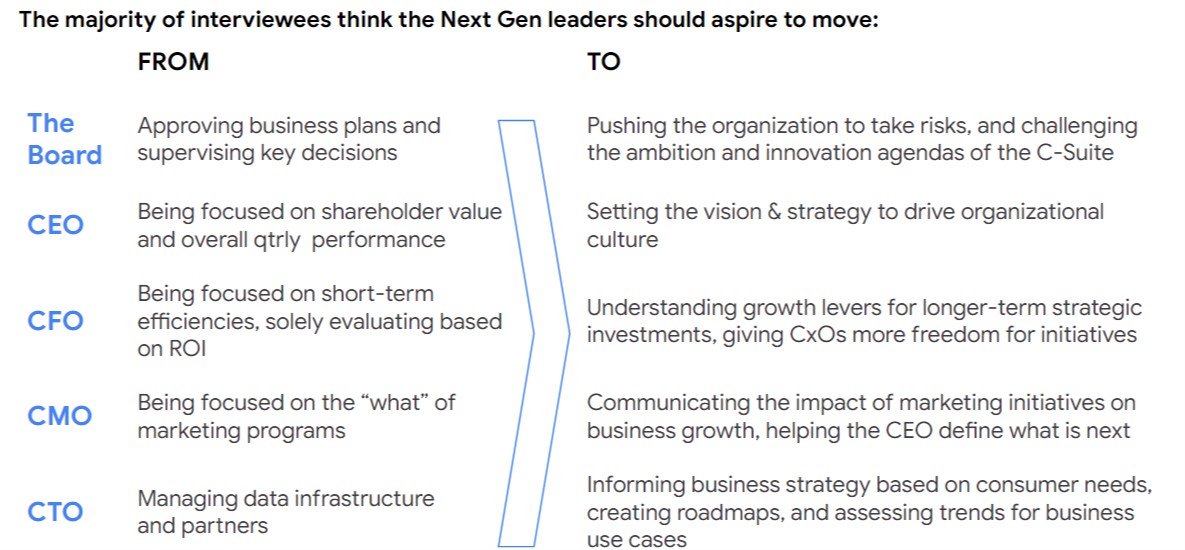Companies that are leaders in the digital space are differentiated by their ability to deliver against ever-shifting consumer demands with sophisticated, personalised experiences that other brands cannot. But they weren’t born into this level of higher maturity; they navigated the rough waters of the shifting market more effectively than their competitors, acquiring new knowledge, better practices, and greater efficiencies along the way. Indeed, "Digitally Leading companies" report having a culture that supports change 20% more often than "Digitally Emerging companies," or those that are in the transformation process.
Building an organisation for tomorrow requires leaders who can guide their teams to success through journeys of transformation. The ability to respond to change while undergoing change and still drive business growth requires a new type of leadership. Practicing this leadership is, perhaps, the biggest barrier to growth for many companies today. Google and Kantar partnered over the summer of 2021 to explore what today's leading companies do differently to drive revenue growth and digital transformation success.
To better understand the priorities and challenges of C-suite leaders, we spoke to 40 C-suite leaders from companies across the U.S., hearing what elements of leadership tend to drive growth, especially through transformation. A key theme that emerged was the intense need for leadership to go beyond accountability for driving vertical performance and instead, lean into collaboration and mutual learning across functions. In essence, moving from championing “type A” leaders to an “A-Team” C-suite.
Building an A-Team in the C-Suite
Organisations with integrated cross-functional business strategies have the advantage, but no single leader can deliver this alone. C-suites and boardrooms are being defined by their collective strengths rather than individual accomplishments. To maximise the benefit from the whole team requires each leader to be forthcoming about their own strengths and weaknesses, and to prioritise active collaboration and understanding of initiatives happening in different functions.
However, practicing this higher degree of vulnerability is made more challenging by the reality that roles and responsibilities of CXOs and board members are changing as rapidly as the business environment in which they operate. Developing a deeper understanding for the value and operations of other verticals is complicated by the fact that traditional standards for age-old functions are in flux. The foundation for a cohesive and collaborative organisation rests on its leaders’ ability to discard egos and focus on helping each other versus creating vertical fiefdoms.
How can each CXO accomplish setting a precedent for collaboration? At a high level, they must lean into understanding the operational aspects of the overall business, as well as the needs of their colleagues in their evolving roles. The CEO has a greater responsibility to set the tone and expectations of the boardroom. And the board, itself, should play a more active role than simply signing off on business as usual.

All leaders we spoke to agreed that building the organisation of the future requires a next-gen C-suite comprised of CXOs willing to operate outside their traditional comfort zones and to think more expansively not only about their own role but the role of the C-suite as a collective. This open, collaborative and inquisitive mindset was cited as a key driver of success through change. Digitally Leading companies lead the way here, with 70% of respondents agreeing that support across the C-suite and the board was critical to the success of their digital transformation initiatives, compared to 46% of respondents from Digitally Emerging companies.
When asked where these leadership changes were most critical for operating in change, two highlights emerged: enhanced collaboration between the CFO and CMO, and the elevated strategic role of the board.
The CFO-CMO Power Pair
As discussed in our article, 5 Keys to a Successful Digital Marketing Transformation, respondents from Digitally Leading companies reported significantly higher levels of collaboration between finance and marketing teams than from Digitally Emerging companies.
69% of respondents agree that a collaborative relationship between their senior-most marketing person and the CFO has a very good impact on the success of a digital transformation project (in comparison to 59% who think otherwise).
Our qualitative findings support this claim. Consensus from all our interviews was that expectations of CMOs and CFOs have shifted the most, but those leaders who prioritised collaboration between these two functions also saw better business outcomes and digital transformation success for their organisations.
Understanding that collaboration doesn’t always come easily, we sought to better understand what CFOs and CMOs must do differently to foster a better partnership:
CFOs
Marketing leaders need their CFO to lean into the operations side of the business to understand what drives actual growth (e.g., consumers/clients), rather than focusing only on delivering the numbers. This means CFOs need to understand the roles that marketing, sales and tech play in delivering growth to be able to act as an effective sparring partner to the respective leaders.
- CFOs must understand consumer needs to help their organisations follow and forecast demand
- CFOs need to understand how and why the business targets certain consumers
- CFOs need to work with the CMO to understand how they can enable experimentation beyond the usual budget constraints
With these tools in place, CFOs can build a better understanding of how measurements of marketing effectiveness can translate into the financial KPIs of business growth, and through this, enable the critical collaboration between teams. Indeed, 71% of respondents who cited a collaborative relationship with the CFO also stated that their approach to measuring marketing effectiveness is fully accepted by finance (vs. only 55% who cited a transactional CMO-CFO relationship).
CMOs
On the flip side, showing the CFO the marketing calendar isn't building a business case for resources. The CFO wants to know the ‘why’ behind marketing initiatives framed in what value they deliver to the business, and when.
- CMOs must help the CFO understand the drivers of marketing, enabling the CFO to make investment allocation decisions by providing business impact metrics
- CMOs need to broaden the scope of their role to lead marketing operations with a financial lens, in addition to traditional marketing comms responsibilities
- CMOs should recruit marketers with financial analysis skills for long-term strategic collaboration with the finance team
Building business and financial acumen within marketing teams is critical to working hand-in-hand with the finance teams. Working with marketing partners to translate marketing investments into impact is an opportunity for most organisations. In fact, 41% of respondents from companies with a marketing leader who can translate marketing metrics to business impact also performed much better than their competitors in terms of revenue growth (vs. 30% respondents with a marketing leader who only speaks in terms of marketing metrics).
Combining strengths into a power-pair model is a huge driver of success for organisations of the future. Building a successful union depends on establishing trust and radical candour, facilitated when both leaders are objective-oriented, open-minded to change and prioritised collaborative—not transactional—relationship building.
The evolution of the CFO-CMO relationship in the context of digital transformation matters even more as these leaders need to collaborate to make joint decisions which can have considerable financial impact. Bridging the gap between these key roles in the C-suite can bring elevated levels of understanding and harmony to the teams; it can set an example for other siloed functions within an organisation to form alliances to bring greater impact to an organisation’s transformation efforts.
The Changing Role of the Board
Second only to the key need for a copacetic CFO and CMO power-pair is the desire for the board to take a more active role as a sparring partner for management. Remembering from our depiction of changing roles in the chart above, there are two critical questions for leaders when re-evaluating the integral role of their boards:
First, do we have the right people? And second, what role should they play in our organisation?
When it comes to people, our interviews revealed a preference for board members currently in-market. Put bluntly, the value-add of retired professionals with decades of experience is now eclipsed by on-the-ground knowledge of new leaders accustomed to working in fast-paced, dynamic environments. Over twice as many respondents from Digitally Leading companies agree that the board should be providing functional expertise, compared to respondents from Digitally Emerging companies.
Plugging knowledge gaps is a significant benefit of having a board with diverse backgrounds and experiences. For example, if an organisation has an under-developed marketing function, adding a board member with marketing expertise is a valuable resource in guiding marketing strategy.
As the make-up of the board evolves, so, too, does the role they play in driving business growth. Many organisations are already shifting away from the old model of the board attending quarterly meetings and signing off on compensation packages; but our research suggests that most organisations are not leveraging the board to their full potential.
Organisations need a provocative board that is actively involved in the strategy, and whose members act as sparring partners to hold management accountable on pushing the agenda with new initiatives. 1 in 3 (35%) of senior-level marketers say that the board of directors should push for major change initiatives. Specifically, interviewees expressed the need for board members who apply experience of having done it before to spot pitfalls, challenge assumptions, and bring energy to new ideas, all of which helps management identify quick wins in moving the business forward.
With all this change comes the greater responsibility for leaders to establish clarity and champion unity from the outset of any transformation journey. When teams lack a clear vision and remain siloed in separate areas, large-scale change programs get side-lined by the complexity of planning in change. A key differentiator of Digitally Leading companies from the rest is their ability to select and support great leaders with the bravery, resilience, and humility to guide their teams through periods of uncertainty. This pivotal role of leading through change does not sit solely with one CXO or another. The entire C-suite and the board are responsible for ensuring their teams and colleagues are set up for success.


